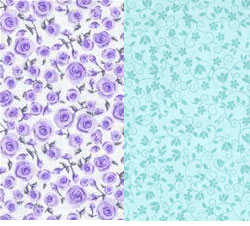 Cotton broadcloth, as such, is uniquely American– broadcloth is a type of weave that was traditionally done in wool, but in the UK they used a cotton named poplin which, when imported to the U.S., was called broadcloth for the U.S. market. It comes in many weights and from snowy white to a myriad of prints, such as those shown in the picture. It comes in many weights from very light, light, medium, heavy and heavier. I never use any weight other than very light or light weight for doll dresses, and prefer the “very light” weight. It also comes in different qualities, so you check the “feel” and weight when shopping for it. I do a lot of shopping on line for both new and old fabrics, and any time I can I will spend a few dollars extra and get a sample before I order. One of my favorite places to buy new fabrics is Fabric.com — for a number of reasons: They have rulers on their fabric pictures showing scale, ( I will talk about scale and its critical importance in doll dresses in a later post) they give you a complete description of the fabric such as weight, size, content and so on, but for a small fee you can order a sample. The sample is worth every penny– you know exactly what you are getting, and you can order as little as a half yard or order more and get a better price on most of their fabrics.
Cotton broadcloth, as such, is uniquely American– broadcloth is a type of weave that was traditionally done in wool, but in the UK they used a cotton named poplin which, when imported to the U.S., was called broadcloth for the U.S. market. It comes in many weights and from snowy white to a myriad of prints, such as those shown in the picture. It comes in many weights from very light, light, medium, heavy and heavier. I never use any weight other than very light or light weight for doll dresses, and prefer the “very light” weight. It also comes in different qualities, so you check the “feel” and weight when shopping for it. I do a lot of shopping on line for both new and old fabrics, and any time I can I will spend a few dollars extra and get a sample before I order. One of my favorite places to buy new fabrics is Fabric.com — for a number of reasons: They have rulers on their fabric pictures showing scale, ( I will talk about scale and its critical importance in doll dresses in a later post) they give you a complete description of the fabric such as weight, size, content and so on, but for a small fee you can order a sample. The sample is worth every penny– you know exactly what you are getting, and you can order as little as a half yard or order more and get a better price on most of their fabrics.
Broadcloth is one of the easiest fabrics to sew and if it is 100% cotton won’t give you trouble with fraying. You can also use a little spray starch for a little extra crispness, which is desirable for heirloom doll dresses. In the days when women would actually iron clothes, new cotton fabric came with sizing which gave the effect of light starch, a lovely crispness to the fabric. This would usually wash out and you would then have to starch the clothes if you wanted the same crispness. Now no one wants to iron anything, so fabric companies instead do everything they can to make the fabric LIMP and not only that, treat the yarns so they won’t even easily take starch. (Don’t worry about ironing doll dresses— once they are on the doll they usually stay!) Synthetic blends are almost impossible to add that touch of crispness that makes the dresses look vintage. Another reason to avoid blends, for heirloom quality dresses, if you are using any form of cotton, always use 100% cotton, never a cotton blend.
Leave questions or comments below. You will NOT be spammed or get a bunch of emails!


